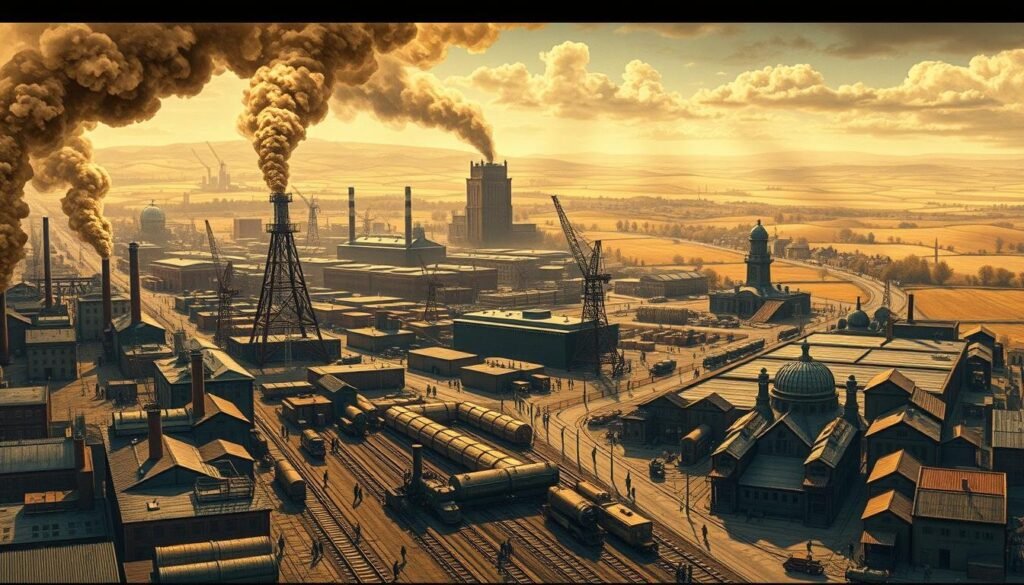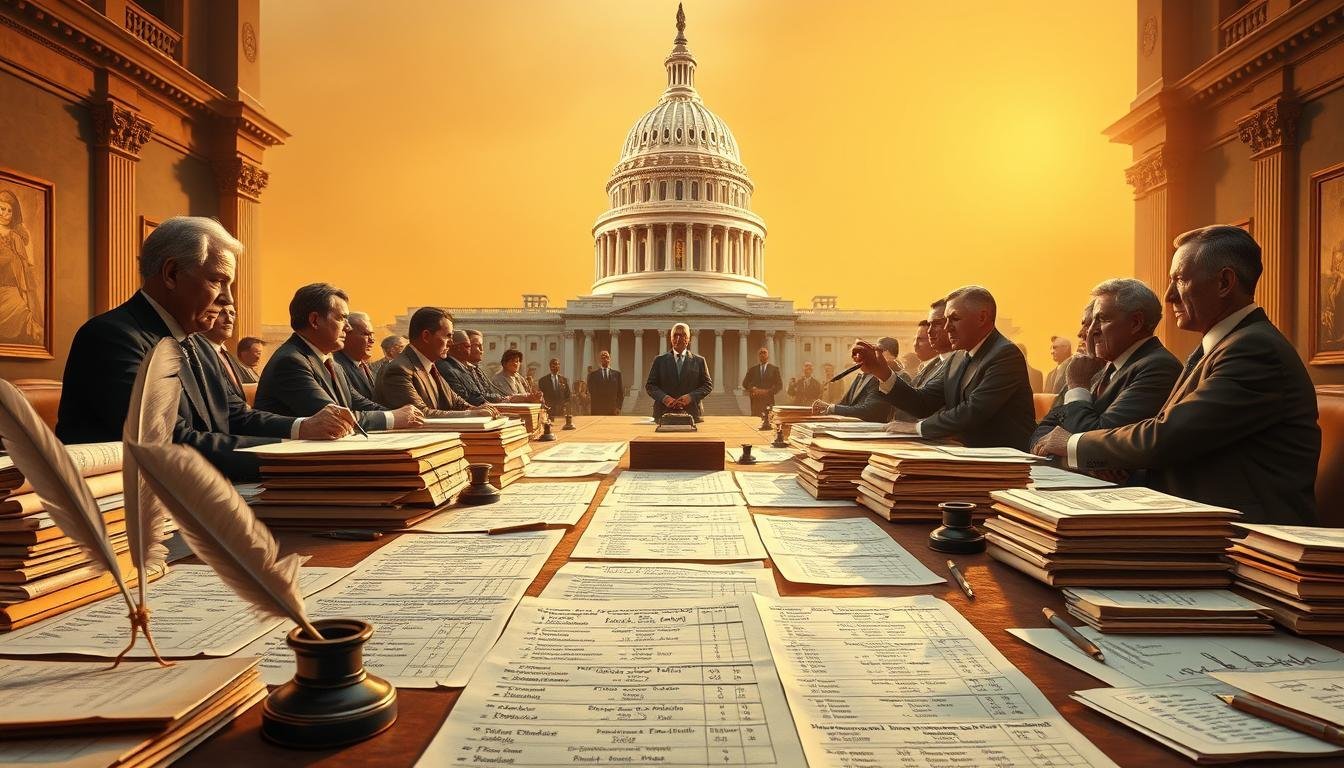During Grover Cleveland’s second term, big changes happened in the US economy. These changes were especially seen in tariff policies. You might be curious about how these changes affected the economy.
Cleveland was the only president to serve two non-consecutive terms. His second presidency brought new challenges and chances. The tariff policies during this time were very important. They greatly influenced trade and commerce.
You will learn about the main events and decisions Cleveland made. These shaped the US economy during his second term. You will understand the big impact of these changes.
Contents
- 1 Cleveland’s Return to Office and Economic Context
- 2 Cleveland’s Previous Tariff Stance
- 3 The Wilson-Gorman Tariff Act of 1894
- 4 What Happened to Tariffs During Cleveland’s Second Presidency
- 5 Political Battles Over Tariff Reform
- 6 Economic Impact of Cleveland’s Tariff Policies
- 7 International Trade Relations Under Cleveland
- 8 Grover Cleveland’s Second Term: A Tariff Legacy
- 9 FAQ
- 9.1 What were the main changes to tariffs during Grover Cleveland’s second term as US president?
- 9.2 What was Grover Cleveland’s stance on protectionism, and how did it influence his tariff policies?
- 9.3 What was the McKinley Tariff, and how did Cleveland criticize it?
- 9.4 What was the Wilson-Gorman Tariff Act of 1894, and what were its key provisions?
- 9.5 What was the impact of the Wilson-Gorman Tariff Act on the US economy?
- 9.6 How did the Supreme Court challenge in Pollock v. Farmers’ Loan & Trust Co. affect the Wilson-Gorman Tariff Act?
- 9.7 What were the political implications of Cleveland’s tariff policies, and how did they impact the 1896 presidential election?
- 9.8 How did Cleveland’s tariff policies affect international trade relations during his presidency?
- 9.9 What was the gold reserve crisis, and how was it related to Cleveland’s economic policies?
Cleveland’s Return to Office and Economic Context
When Cleveland started his second term, the economy was in trouble. People thought the tariff system needed a big change.
Cleveland didn’t like protectionism. He thought high tariffs hurt consumers and the whole economy.
Opposition to Protectionism
Not everyone agreed with Cleveland on tariffs. Many business leaders and Republicans thought tariffs were key to keeping jobs and industries in the US.
- The debate over tariffs was a central issue in Cleveland’s second term.
- Cleveland believed lower tariffs would help the economy.
- His opponents said lower tariffs would make American industries face unfair competition.
During Cleveland’s second term, there was a big push for tariff reform. Cleveland wanted to lower tariffs because he believed in free trade’s benefits for the US economy.
Cleveland’s Previous Tariff Stance
Cleveland had strong views on tariffs, especially protectionism. Before his second term, he spoke out against high tariffs. He was critical of the McKinley Tariff, saying it hurt American trade.
The McKinley Tariff, passed in 1890, raised taxes on imported goods. Cleveland argued it favored some industries over others. He thought it made things more expensive for everyone.
His views on tariffs were shaped by his first term’s economic troubles. High tariffs had cut down on farm exports, causing problems.
The Wilson-Gorman Tariff Act of 1894
The Wilson-Gorman Tariff Act of 1894 was a major change in the U.S. economy during Cleveland’s second term. It came from long debates over tariffs. It showed Cleveland’s strong push for tariff reform.
This act had important parts. It lowered tariffs on some goods and added a 2% income tax on incomes over $4,000. This change was a big step in Cleveland’s effort to fix economic unfairness.
The income tax part of the act faced a big challenge in the Supreme Court case Pollock v. Farmers’ Loan & Trust Co. The court said the income tax was unconstitutional. They argued it was a direct tax not divided fairly among states, as the Constitution demands.
| Key Provisions | Economic Impact |
|---|---|
| Reduction in Tariff Rates | Stimulated Trade |
| Introduction of Income Tax | Redistributive Economic Policy |
| Supreme Court Challenge | Income Tax Ruled Unconstitutional |
The Wilson-Gorman Tariff Act and its legal fight show the tough job of making economic policies during Cleveland’s time. Even with the legal setback, the act is a key part of U.S. economic policy history.
What Happened to Tariffs During Cleveland’s Second Presidency
During Cleveland’s second presidency, big changes happened in tariffs. These changes had a big impact on the economy. They especially affected manufacturing.
The Wilson-Gorman Tariff Act of 1894 was a key law during this time. It tried to fix the old tariff system, which was a big issue. People had different views on its effects on the economy.
Tariff changes during Cleveland’s second term affected manufacturing costs a lot. The Wilson-Gorman Tariff Act changed tariffs on raw materials. This changed production costs and the prices of final goods.
- Lowering tariffs on some raw materials made production cheaper for some industries.
- But, keeping high tariffs on other goods meant some manufacturers still had high costs.
- The overall effect was mixed, with some industries doing well and others struggling.
It’s important to understand these changes to see how Cleveland’s tariff policies affected the economy. The impact was different for each sector, showing how complex the economy is.
Political Battles Over Tariff Reform
The political scene in Cleveland’s second term was all about tariff reform. This debate was more than just about money. It was about the future of the nation.
Tariff reform hit many industries and people hard. Protectionism, or protecting home industries with tariffs, was a big part of the fight. Supporters said it saved jobs and industries. But critics said it made things more expensive for everyone and favored some industries too much.
Setting the Stage for the 1896 Election
The fight over tariffs was a big deal for the 1896 election. Everyone had strong feelings about it. Here’s a quick look at what some big names thought about tariffs.
| Political Figure | Position on Tariff Reform |
|---|---|
| Cleveland | Advocated for lower tariffs |
| Republicans | Generally supported protectionism |
| Democrats | Divided, but some supported reform |
It’s clear that tariffs were a big issue, splitting parties. The 1896 election would show how the public felt about tariffs.
The battles over tariffs in Cleveland’s second term showed deep divisions in the country. These debates were not just about now. They shaped American politics and economy for years to come.
Economic Impact of Cleveland’s Tariff Policies
Have you ever thought about how Cleveland’s tariff policies affected the US economy? His second presidency saw big economic challenges because of these policies. They had a big impact on US trade and the financial system.
The Wilson-Gorman Tariff Act of 1894 was a key law during Cleveland’s time. It lowered tariffs but didn’t please everyone who wanted free trade. This led to mixed results for the economy.

Cleveland also had to deal with a gold reserve crisis. The gold reserve was running low, which threatened the financial stability of the US. To fix this, Cleveland had to get a loan from a group of bankers, led by J.P. Morgan.
The effects of Cleveland’s tariff policies were complex. They had both short-term and long-term impacts on the US economy. Learning about these policies helps us understand the challenges Cleveland faced and how he tried to solve them. This shaped US trade policies for years to come.
International Trade Relations Under Cleveland
Cleveland’s view on international trade was key to his economic plan. During his time in office, the US made big strides in trade with other nations.
He focused on making trade deals and solving trade problems. Cleveland wanted to open markets but also protect American jobs.
| Trade Agreement | Year | Impact |
|---|---|---|
| Reciprocal Trade Agreement with Canada | 1894 (Failed to pass) | Potential for increased trade, but met resistance |
| Tariff Reform | 1894 (Wilson-Gorman Tariff Act) | Moderate reduction in tariffs, but maintained protectionist elements |
Cleveland’s leadership showed a careful balance in international trade. He aimed to boost the US economy while dealing with tough diplomatic issues.
Grover Cleveland’s Second Term: A Tariff Legacy
Grover Cleveland’s second term was filled with debates over tariffs. The Wilson-Gorman Tariff Act of 1894 was a key piece of legislation. It showed the complexity of Cleveland’s tariff stance.
Tariffs changed a lot during Cleveland’s second term. These changes were shaped by the economy and political fights. They affected international trade and the economy as a whole.
Looking back, Cleveland’s tariff policies had a big impact on the US economy. The struggles and compromises around tariff reform during this time offer valuable lessons. They show how complex economic policy-making can be.
FAQ
What were the main changes to tariffs during Grover Cleveland’s second term as US president?
During Grover Cleveland’s second term, a big change happened. The Wilson-Gorman Tariff Act of 1894 was passed. It greatly changed the US tariff system.
What was Grover Cleveland’s stance on protectionism, and how did it influence his tariff policies?
Grover Cleveland didn’t like protectionism. This belief shaped his tariff policies. He worked to reform the tariff system.
What was the McKinley Tariff, and how did Cleveland criticize it?
The McKinley Tariff was a law passed in 1890. It was protectionist. Cleveland thought it was bad for the economy.
What was the Wilson-Gorman Tariff Act of 1894, and what were its key provisions?
The Wilson-Gorman Tariff Act of 1894 was a big change. It lowered tariffs on some goods and introduced an income tax.
What was the impact of the Wilson-Gorman Tariff Act on the US economy?
The Wilson-Gorman Tariff Act changed the US economy a lot. It affected manufacturing costs and trade policies.
How did the Supreme Court challenge in Pollock v. Farmers’ Loan & Trust Co. affect the Wilson-Gorman Tariff Act?
The Supreme Court’s challenge in Pollock v. Farmers’ Loan & Trust Co. was big. It especially affected the income tax part of the Wilson-Gorman Tariff Act.
What were the political implications of Cleveland’s tariff policies, and how did they impact the 1896 presidential election?
Cleveland’s tariff policies were very political. They helped shape the debates and issues of the 1896 presidential election.
How did Cleveland’s tariff policies affect international trade relations during his presidency?
Cleveland’s tariff policies had big effects on international trade. They influenced how the US traded with other countries.
The gold reserve crisis was a big economic challenge. It was linked to Cleveland’s economic policies, including his tariff policies and their impact on the financial system.

Hi, I am Tatum Bradford from Washington. I have a background in political science and work as a senior revenue officer. I love learning about U.S. presidents and sharing interesting facts about political history.

